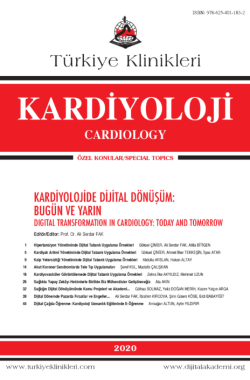Digital Based Application Examples in Cardiac Arrhythmia Management
Göksel ÇİNİERa,b,Ahmet İlker TEKKEŞİNa, İlyas ATARc
aİstanbul Dr. Siyami Ersek Göğüs Kalp ve Damar Cerrahisi Eğitim ve Araştırma Hastanesi, Kardiyoloji Kliniği, İstanbul, TÜRKİYE
bQueen’s Üniversitesi Tıp Fakültesi, Kardiyoloji Bölümü, Kingston, Ontario, KANADA
cGüven Hastanesi, Kardiyoloji Kliniği, Ankara, TÜRKİYE
Çinier G, Tekkeşin Aİ, Atar İ. Kardiyak aritmi yönetiminde dijital tabanlı uygulama örnekleri. Fak AS, editör. Kardiyolojide Dijital Dönüşüm: Bugün ve Yarın. 1. Baskı. Ankara: Türkiye Klinikleri; 2020. p.5-8.
ABSTRACT
Digital health applications are being increasingly used for the management of cardiac arrhythmia patients. These applications include atrial fibrillation (AF) screening by using wearable health technologies, AF prediction models from electrocardiography (ECG) that are recorded in electronic health database and by using machine learning methods and artificial intelligence and telemedicine by using web or mobile based applications in the management of cardiac rhythm disturbances and patients with implanted cardiac devices. We need more evidence from randomized clinical trials. Ethical issues regarding data privacy should also be addressed before the implementation of these applications into routine clinical practice.
Keywords: Atrial fibrillation; digital health; atriyal fibrilasyon
Kaynak Göster
Referanslar
- Piwek l, Ellis DA, Andrews S, et al: The rise of consumer health wearables: promises and barriers. ploS Med. 2016;13(2):e1001953. [Crossref] [PubMed] [PMC]
- Lamkin p: Wearable tech market to be worth $34 billion by 2020. Forbes 2016.
- Sanna T, Diener H-C, passman RS, et al: Cryptogenic stroke and underlying atrial fibrillation. N Engl j Med. 2014;370(26):2478-86. [Crossref] [PubMed]
- Halcox jp, Wareham K, Cardew A, et al: Assessment of remote heart rhythm sampling using the AliveCor heart monitor to screen for atrial fibrillation: the REHEARSE-AF study. Circulation. 2017;136(19):1784-94. [Crossref] [PubMed]
- Page Rl, Wilkinson WE, Clair WK, et al: Asymptomatic arrhythmias in patients with symptomatic paroxysmal atrial fibrillation and paroxysmal supraventricular tachycardia. Circulation. 1994;89(1):224-7. [Crossref] [PubMed]
- Van Gelder ıC, Healey jS, Crijns Hj, et al: Duration of device-detected subclinical atrial fibrillation and occurrence of stroke in ASSERT. Eur Heart j. 2017;38(17):1339-44. [Crossref] [PubMed]
- Jaakkola j, Mustonen p, Kiviniemi T, et al: Stroke as the first manifestation of atrial fibrillation. ploS One. 2016;11(12):e0168010. [Crossref] [PubMed] [PMC]
- Lowres N, Neubeck l, Redfern j, et al: Screening to identify unknown atrial fibrillation. Thromb Haemost. 2013;110(08):213-22. [Crossref] [PubMed]
- Svennberg E, Engdahl j, Al-Khalili F, et al: Mass screening for untreated atrial fibrillation: the STROKESTOp study. Circulation. 2015; 131(25):2176-84. [Crossref] [PubMed]
- Engdahl j, Andersson l, Mirskaya M, et al: Stepwise screening of atrial fibrillation in a 75- year-old population: implications for stroke prevention. Circulation. 2013;127(8):930-7. [Crossref] [PubMed]
- Perez MV, Mahaffey KW, Hedlin H, et al: large-scale assessment of a smartwatch to identify atrial fibrillation. N Engl j Med. 2019; 381(20):1909-17. [Crossref] [PubMed] [PMC]
- Campion EW, jarcho jA: Watched by Apple. ın.: Mass Medical Soc; 2019. [Crossref] [PubMed]
- Kirchhof p, Benussi S, Kotecha D, et al: 2016 ESC Guidelines for the management of atrial fibrillation developed in collaboration with EACTS The Task Force for the management of atrial fibrillation of the European Society of Cardiology (ESC) Developed with the special contribution of the European Heart Rhythm Association (EHRA) of the ESCEndorsed by the European Stroke Organisation (ESO). Eur j Cardiothorac Surg. 2016:ezw313.
- Jones NR, Taylor Cj, Hobbs FR, et al: Screening for atrial fibrillation: a call for evidence. Eur Heart j. 2020;41(10):1075-85. [Crossref] [PubMed] [PMC]
- Kottkamp H: Human atrial fibrillation substrate: towards a specific fibrotic atrial cardiomyopathy. Eur Heart j. 2013;34(35):2731-8. [Crossref] [PubMed]
- Attia Zı, Noseworthy pA, lopez-jimenez F, et al: An artificial intelligence-enabled ECG algorithm for the identification of patients with atrial fibrillation during sinus rhythm: a retrospective analysis of outcome prediction. The lancet. 2019;394(10201):861-7. [Crossref] [PubMed]
- Bhalla V, ısakson S, Bhalla MA, et al: Diagnostic ability of B-type natriuretic peptide and impedance cardiography: testing to identify left ventricular dysfunction in hypertensive patients. Am j Hypertens. 2005;18(S2):73S-81S. [Crossref] [PubMed]
- Wu j-T, Wang S-l, Chu Y-j, et al: CHADS2 and CHA2DS2-VASc scores predict the risk of ischemic stroke outcome in patients with interatrial block without atrial fibrillation. journal of atherosclerosis and thrombosis 2016: 34900.
- Bodenheimer T, Wagner EH, Grumbach K: ımproving primary care for patients with chronic illness. jAMA. 2002;288(14):1775-9. [Crossref] [PubMed]
- Guo Y, Chen Y, lane DA, et al: Mobile health technology for atrial fibrillation management integrating decision support, education, and patient involvement: mAF App Trial. The American journal of medicine. 2017; 130(12): 1388- 96. e1386. [Crossref] [PubMed]
- Orchard j, Neubeck l, Freedman B, et al: eHealth tools to provide structured assistance for atrial fibrillation screening, management, and Guideline‐Recommended therapy in metropolitan general practice: the AF‐SMART study. journal of the American Heart Association. 2019;8(1):e010959. [Crossref] [PubMed] [PMC]
- Dalouk K, Gandhi N, jessel p, et al: Outcomes of telemedicine video-conferencing clinic versus in-person clinic follow-up for implantable cardioverter-defibrillator recipients. Circulation: Arrhythmia and Electrophysiology. 2017;10(9):e005217. [Crossref] [PubMed]

